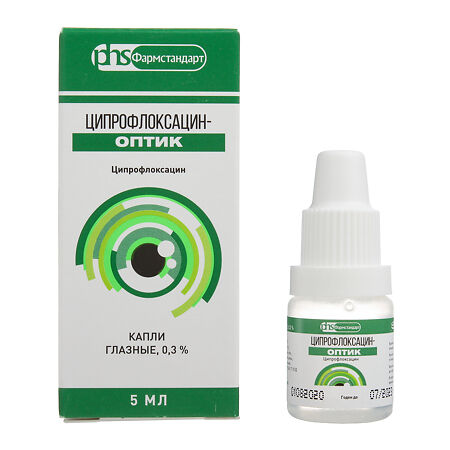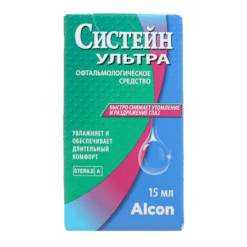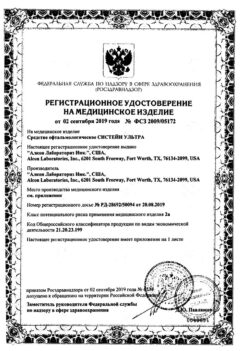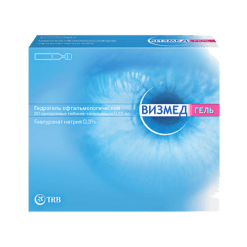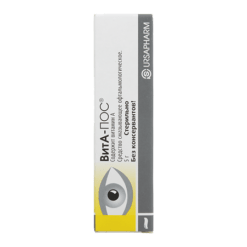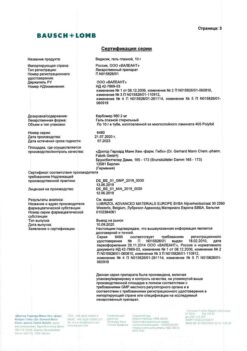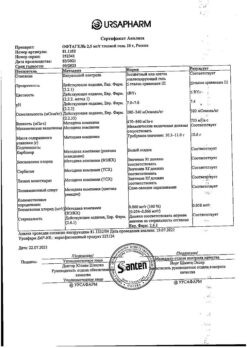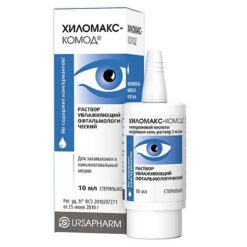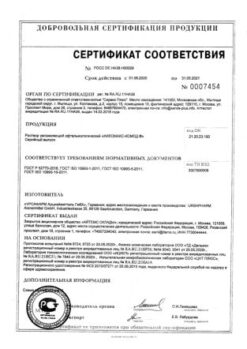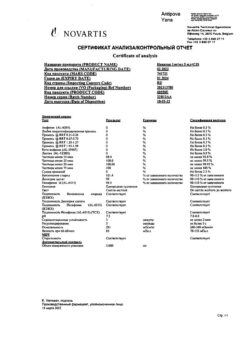No products in the cart.
Ciprofloxacin-Optic, eye drops 0.3% 5 ml
€3.62 €3.02
Description
Pharmacotherapeutic group: antimicrobial agent – fluoroquinolone
ATX code: S01AX13
Pharmacological properties
Pharmacodynamics
A broad-spectrum antimicrobial agent, a fluoroquinolone derivative, inhibits bacterial DNA gyrase (topoisomerases II and IV, responsible for the process of superspiralization of chromosomal DNA around nuclear RNA, which is required for the reading of genetic information); disrupts DNA synthesis, bacterial growth and division; causes pronounced morphological changes (including cell wall and membranes) and rapid death of the bacterial cell.
Bactericidal on Gram-negative organisms during quiescence and fission (as it affects not only DNA-gyrase, but also causes lysis of cell wall), on Gram-positive microorganisms – only during fission.
Low toxicity to macroorganism cells is explained by the absence of DNA-gyrase in them. Against the background of ciprofloxacin use there is no parallel development of resistance to other antibiotics which do not belong to gyrase inhibitors group and this makes it highly effective against bacteria which are resistant to, for example, aminoglycosides, penicillins, cephalosporins, tetracyclines and many other antibiotics.
Ciprofloxacin is sensitive to Gram-negative aerobic bacteria: enterobacteriaceae (Escherichia coli, Salmonella spp, Shigella spp., Citrobacter spp., Klebsiella spp., Enterobacter spp., Proteus mirabilis, Proteus vulgaris, Serratia marcescens, Hafnia alvei, Edwardsiella tarda, Providencia spp, Morganella morganii, Vibrio spp., Yersinia spp.), other Gram-negative bacteria (Haemophilus spp., Pseudomonas aeruginosa, Moraxella catarrhalis, Aeromonas spp., Pasteurella multocida, Plesiomonas shigeoides, Campylobacter jejuni, Neisseria spp.); some intracellular pathogens (Legionella pneumophila, Brucella spp, Chlamydia trachomatis, Listeria monocytogenes, Mycobacterium tuberculosis, Mycobacterium kansasii, Corynebacterium diphtheria); Gram-positive aerobic bacteria: Staphylococcus spp. (Staphylococcus aureus, Staphylococcus haemolyticus, Staphylococcus hominis, Staphylococcus saprophyticus), Streptococcus spp. (Streptococcus pyogenes, Streptococcus agalac-tiae).
Most methicillin-resistant staphylococci are also resistant to ciprofloxacin. The sensitivity of Streptococcus pneumoniae, Enterococcus faecalis, Mycobacterium avium (located intracellularly) is moderate (high concentrations are required for their suppression).
Bacteroides fragilis, Pseudomonas cepacia, Pseudomonas maltophilia, Ureaplasma urealyticum, Clostridium difficile, Nocardia asteroides are resistant to the drug. It is ineffective against Treponema pallidum.
Resistance develops very slowly because, on the one hand, after the action of ciprofloxacin there are almost no persistent microorganisms, and on the other hand, bacterial cells have no enzymes that inactivate it.
Mechanisms of resistance development
The development of resistance to fluoroquinolones, particularly to ciprofloxacin, is mediated by changes in genes encoding at least one of 4 mechanisms:
1. Changes in the structure of target enzymes (DNA-gyrase and topoisomerase IV) – enzymes involved in cellular DNA synthesis;
2. Disruption of cell wall permeability;
3. Active drug withdrawal from the cell (increased efflux pump activity);
4. Plasmid-mediated changes in aminoglycoside 6-N-acetyltransferase activity.
Pharmacokinetics
Absorption
It is rapidly absorbed when applied topically.
Distribution
The plasma concentration of ciprofloxacin after instillation into the conjunctiva of 2 drops of 0.3% solution every 2 hours for 2 days and then every 4 hours for 5 days ranged from unquantifiable (< 1.0 ng/mL) to 4.7 ng/mL. The mean maximum plasma concentration of ciprofloxacin obtained in this study was approximately 450 times lower than after oral ciprofloxacin doses of 250 mg.
Ciprofloxacin is widely distributed in body tissues, with approximately 1.7 to 5 L/kg of distribution. Binding to plasma proteins is 20-40 %.
Metabolism
There is no information about the ways of metabolism of ciprofloxacin.
Elimation
The half-life from plasma is 3-5 hours. Ciprofloxacin and its four metabolites are excreted with urine and feces. About 2/3 of the total level of ciprofloxacin in plasma is eliminated through the kidneys, while 1/3 of the total level of ciprofloxacin is excreted through the intestine and with the bile. In patients with impaired renal function a slight increase in the elimination half-life of ciprofloxacin is observed due to extrarenal routes of elimination. Similarly, in patients with hepatic impairment the elimination half-life is slightly prolonged.
There are no data on the study of pharmacokinetic properties of ciprofloxacin in children.
There are no data on the study of pharmacokinetic properties of ciprofloxacin in children.
Indications
Indications
Treatment of corneal ulcers and infections of the anterior segment of the eyeball and its appendages caused by bacteria sensitive to ciprofloxacin in adults, newborns (0 to 27 days), infants and infants (28 to 23 months), children (2 to 11 years) and adolescents (12 to 18 years).
Pharmacological effect
Pharmacological effect
Pharmacotherapeutic group: antimicrobial agent – fluoroquinolone
ATC code: S01AX13
Pharmacological properties
Pharmacodynamics
A broad-spectrum antimicrobial agent, a fluoroquinolone derivative, inhibits bacterial DNA gyrase (topoisomerases II and IV, responsible for the process of supercoiling of chromosomal DNA around nuclear RNA, which is necessary for reading genetic information); disrupts DNA synthesis, growth and division of bacteria; causes pronounced morphological changes (including cell wall and membranes) and rapid death of the bacterial cell.
It has a bactericidal effect on gram-negative organisms during the period of rest and division (since it affects not only DNA gyrase, but also causes lysis of the cell wall), on gram-positive microorganisms – only during the period of division.
Low toxicity for the cells of the macroorganism is explained by the absence of DNA gyrase in them. While taking ciprofloxacin, there is no parallel development of resistance to other antibiotics that do not belong to the group of gyrase inhibitors, which makes it highly effective against bacteria that are resistant, for example, to aminoglycosides, penicillins, cephalosporins, tetracyclines and many other antibiotics.
Gram-negative aerobic bacteria are sensitive to ciprofloxacin: enterobacteria (Escherichia coli, Salmonella spp., Shigella spp., Citrobacter spp., Klebsiella spp., Enterobacter spp., Proteus mirabilis, Proteus vulgaris, Serratia marcescens, Hafnia alvei, Edwardsiella tarda, Providencia spp., Morganella morganii, Vibrio spp., Yersinia spp.), other gram-negative bacteria (Haemophilus spp., Pseudomonas aeruginosa, Moraxella catarrhalis, Aeromonas spp., Pasteurella multocida, Plesiomonas shigeoides, Campylobacter jejuni, Neisseria spp.); some intracellular pathogens (Legionella pneumophila, Brucella spp., Chlamydia trachomatis, Listeria monocytogenes, Mycobacterium tuberculosis, Mycobacterium kansasii, Corynebacterium diphtheria); gram-positive aerobic bacteria: Staphylococcus spp. (Staphylococcus aureus, Staphylococcus haemolyticus, Staphylococcus hominis, Staphylococcus saprophyticus), Streptococcus spp. (Streptococcus pyogenes, Streptococcus agalactiae).
Most staphylococci resistant to methicillin are also resistant to ciprofloxacin. The sensitivity of Streptococcus pneumoniae, Enterococcus faecalis, Mycobacterium avium (located intracellularly) is moderate (high concentrations are required to suppress them).
The following are resistant to the drug: Bacteroides fragilis, Pseudomonas cepacia, Pseudomonas maltophilia, Ureaplasma urealyticum, Clostridium difficile, Nocardia asteroides. Ineffective against Treponema pallidum.
Resistance develops extremely slowly, since, on the one hand, after the action of ciprofloxacin there are practically no persistent microorganisms left, and on the other hand, bacterial cells do not have enzymes that inactivate it.
Mechanisms of resistance development
The development of resistance to fluoroquinolones, in particular to ciprofloxacin, is mediated through changes in genes encoding at least one of 4 mechanisms:
1. change in the structure of target enzymes (DNA gyrase and topoisomerase IV) – enzymes involved in the synthesis of cell DNA;
2. violation of cell wall permeability;
3. active removal of the drug from the cell (increased activity of efflux pumps);
4. plasmid-mediated changes in the functioning of aminoglycoside 6-N-acetyltransferase.
Pharmacokinetics
Absorption
When applied topically, it is quickly absorbed.
Distribution
Plasma concentrations of ciprofloxacin following conjunctival instillation of 2 drops of a 0.3% solution every 2 hours for 2 days and then every 4 hours for 5 days ranged from non-quantifiable (< 1.0 ng/ml) to 4.7 ng/ml. The mean maximum plasma concentration of ciprofloxacin obtained in this study was approximately 450 times less than that observed after oral ciprofloxacin at a dose of 250 mg.
Ciprofloxacin is widely distributed in body tissues, with an approximate volume of distribution of 1.7 to 5 L/kg. The connection with blood plasma proteins is 20-40%.
Metabolism
No information is available on the metabolic pathways of ciprofloxacin.
Elimination
The half-life from plasma is 3-5 hours. Ciprofloxacin and its four metabolites are excreted in urine and feces. About 2/3 of the total level of ciprofloxacin in plasma is eliminated through the kidneys, while 1/3 of the total level of ciprofloxacin is excreted through the intestines and bile. In patients with renal impairment, there is a slight increase in the half-life of ciprofloxacin due to extrarenal elimination routes. Similarly, in case of liver dysfunction, the half-life is slightly prolonged.
There is no information on studying the pharmacokinetic properties of ciprofloxacin when used in children.
Special instructions
Special instructions
The solution in the form of eye drops is not intended for intraocular injection.
Active ingredient
Active ingredient
Ciprofloxacin
Composition
Composition
For 1 ml:
Active ingredient:
ciprofloxacin hydrochloride – 3.49 mg, equivalent to ciprofloxacin – 3.0 mg
Excipients:
disodium edetate dihydrate (trilon B) – 0.4 mg,
sodium chloride – 9 mg,
benzalkonium chloride – 0.2 mg,
sodium hydroxide solution 1 M – to pH 3.5-5.5,
purified water – up to 1.0 ml
Pregnancy
Pregnancy
Fertility
Contraindications
Contraindications
Hypersensitivity to the active substance and any of the excipients.
Hypersensitivity to quinolones.
Side Effects
Side Effects
In clinical studies, the most commonly reported adverse events were ocular discomfort (6% of cases), dysgeusia (3% of cases), and corneal precipitates (3% of cases).
Adverse reactions obtained during clinical trials and according to post-marketing surveillance data are grouped according to the following gradation of frequency of occurrence: very often (≥1/10), often (from ≥1/100 to <1/10), infrequently (from ≥1/1000 to <1/100), rarely (from ≥1/10000 to <1/1000), very rarely (< 1/10000), with an unknown frequency (the frequency of occurrence cannot be determined based on available information). In each group, reactions are listed in order of their occurrence.
Organ system
Adverse events
Immune system disorders
Rarely: hypersensitivity reactions.
Nervous disorders
systems
Uncommon: headache.
Rarely: dizziness.
Visual disorders
Common: corneal precipitates, ocular discomfort, conjunctival injection.
Uncommon: keratopathy, punctate keratitis, corneal infiltrates, photophobia, decreased visual acuity, swelling of the eyelids, blurred vision, pain in the eye, feeling of dryness in the eye, swelling of the conjunctiva and eyelids, lacrimation, discharge from the eyes, crusting on the edges of the eyelids, peeling of the skin of the eyelids, hyperemia of the eyelids.
Rarely: toxic effects on the organ of vision, keratitis, conjunctivitis, corneal epithelial defect, diplopia, decreased sensitivity of the cornea, asthenopia, stye.
Disorders of the hearing organ and labyrinth
Rarely: ear pain.
Respiratory, thoracic and mediastinal disorders
Rarely: increased secretion of mucous membrane of the paranasal sinuses, rhinitis.
Disorders of the digestive system
Common: dysgeusia.
Uncommon: nausea.
Rarely: abdominal pain, diarrhea.
Skin and subcutaneous tissue disorders
Rarely: dermatitis.
Musculoskeletal and connective tissue disorders
With unknown frequency: disorders of the ligamentous apparatus.
Description of individual groups of adverse reactions
Rare cases of generalized rash, toxic epidermolysis, exfoliative dermatitis, Stevens-Johnson syndrome and urticaria have been reported.
Serious anaphylactic reactions, in rare cases fatal, including after the first dose, have been reported in patients receiving oral fluoroquinolones. Some of these reactions were accompanied by cardiovascular collapse, loss of consciousness, swelling of the larynx and face, tingling sensations, dyspnea, itching and urticaria.
In patients taking oral fluoroquinolones, ruptures of the shoulder tendons, hand tendons, Achilles tendons, and other tendons have occurred, subsequently requiring surgery or resulting in long-term disability. During clinical studies and post-marketing surveillance, there was no effect of ciprofloxacin instillations on the condition of the musculoskeletal system and connective tissue.
In some cases, during instillation of ciprofloxacin, blurred vision, decreased visual acuity, and a residual amount of the drug on the surface of the cornea were observed.
Moderate to severe phototoxicity reactions have been reported with systemic use of quinolones, but such reactions are not common with ciprofloxacin.
Adverse Reaction Profile in the Pediatric Population
The effectiveness and safety of ciprofloxacin in children aged 0 to 12 years was confirmed in clinical studies involving 230 children. No serious adverse events were observed in this group of patients.
Interaction
Interaction
No specific interaction studies have been conducted with the use of ophthalmic dosage forms of ciprofloxacin.
Taking into account the low systemic concentration of ciprofloxacin in plasma after instillation into the conjunctival cavity, interaction between drugs co-administered with ciprofloxacin is unlikely. In case of combined use with other local ophthalmic drugs, the interval between their use should be at least 5 minutes, and eye ointments should be used last.
Ciprofloxacin-Optic solution is incompatible with solutions of drugs with pH values of 3-4 that are physically or chemically unstable.
Overdose
Overdose
In case of overdose with local use in the form of instillations, it is necessary to rinse the conjunctival cavity with warm water.
Storage conditions
Storage conditions
At a temperature not exceeding 25 °C.
Keep out of the reach of children.
Shelf life
Shelf life
3 years.
Manufacturer
Manufacturer
Lecco CJSC, Russia
Additional information
| Shelf life | 3 years. |
|---|---|
| Conditions of storage | At a temperature not exceeding 25 ° C. Store out of the reach of children. |
| Manufacturer | Lekko ZAO, Russia |
| Medication form | eye drops |
| Brand | Lekko ZAO |
Related products
Buy Ciprofloxacin-Optic, eye drops 0.3% 5 ml with delivery to USA, UK, Europe and over 120 other countries.

